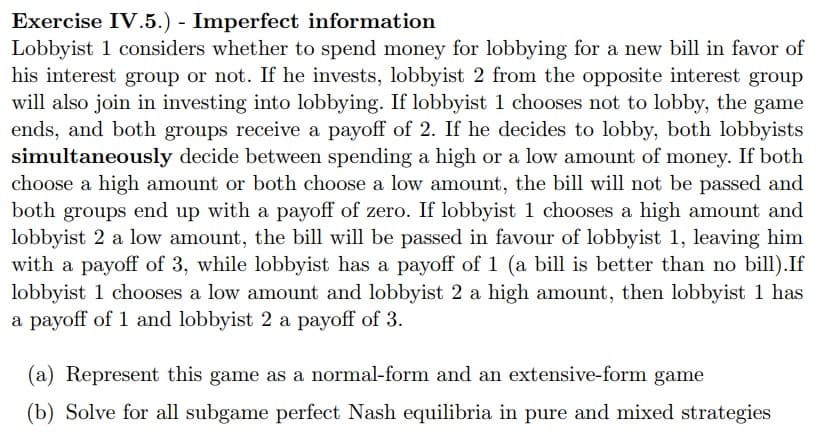Lobbyist 1 considers whether to spend money for lobbying for a new bill in favor of his interest group or not. If he invests, lobbyist 2 from the opposite interest group will also join in investing into lobbying. If lobbyist 1 chooses not to lobby, the game ends, and both groups receive a payoff of 2. If he decides to lobby, both lobbyists simultaneously decide between spending a high or a low amount of money. If both choose a high amount or both choose a low amount, the bill will not be passed and both groups end up with a payoff of zero. If lobbyist 1 chooses a high amount and lobbyist 2 a low amount, the bill will be passed in favour of lobbyist 1, leaving him with a payoff of 3, while lobbyist has a payoff of 1 (a bill is better than no bill).If lobbyist 1 chooses a low amount and lobbyist 2 a high amount, then lobbyist 1 has
Lobbyist 1 considers whether to spend money for lobbying for a new bill in favor of his interest group or not. If he invests, lobbyist 2 from the opposite interest group will also join in investing into lobbying. If lobbyist 1 chooses not to lobby, the game ends, and both groups receive a payoff of 2. If he decides to lobby, both lobbyists simultaneously decide between spending a high or a low amount of money. If both choose a high amount or both choose a low amount, the bill will not be passed and both groups end up with a payoff of zero. If lobbyist 1 chooses a high amount and lobbyist 2 a low amount, the bill will be passed in favour of lobbyist 1, leaving him with a payoff of 3, while lobbyist has a payoff of 1 (a bill is better than no bill).If lobbyist 1 chooses a low amount and lobbyist 2 a high amount, then lobbyist 1 has
Chapter2: Mathematics For Microeconomics
Section: Chapter Questions
Problem 2.15P
Related questions
Question
This question is about the

Transcribed Image Text:Exercise IV.5.) - Imperfect information
Lobbyist 1 considers whether to spend money for lobbying for a new bill in favor of
his interest group or not. If he invests, lobbyist 2 from the opposite interest group
will also join in investing into lobbying. If lobbyist 1 chooses not to lobby, the game
ends, and both groups receive a payoff of 2. If he decides to lobby, both lobbyists
simultaneously decide between spending a high or a low amount of money. If both
choose a high amount or both choose a low amount, the bill will not be passed and
both groups end up with a payoff of zero. If lobbyist 1 chooses a high amount and
lobbyist 2 a low amount, the bill will be passed in favour of lobbyist 1, leaving him
with a payoff of 3, while lobbyist has a payoff of 1 (a bill is better than no bill).If
lobbyist 1 chooses a low amount and lobbyist 2 a high amount, then lobbyist 1 has
a payoff of 1 and lobbyist 2 a payoff of 3.
(a) Represent this game as a normal-form and an extensive-form game
(b) Solve for all subgame perfect Nash equilibria in pure and mixed strategies
Expert Solution
This question has been solved!
Explore an expertly crafted, step-by-step solution for a thorough understanding of key concepts.
This is a popular solution!
Trending now
This is a popular solution!
Step by step
Solved in 3 steps with 3 images

Knowledge Booster
Learn more about
Need a deep-dive on the concept behind this application? Look no further. Learn more about this topic, economics and related others by exploring similar questions and additional content below.Recommended textbooks for you


Managerial Economics: A Problem Solving Approach
Economics
ISBN:
9781337106665
Author:
Luke M. Froeb, Brian T. McCann, Michael R. Ward, Mike Shor
Publisher:
Cengage Learning


Managerial Economics: A Problem Solving Approach
Economics
ISBN:
9781337106665
Author:
Luke M. Froeb, Brian T. McCann, Michael R. Ward, Mike Shor
Publisher:
Cengage Learning